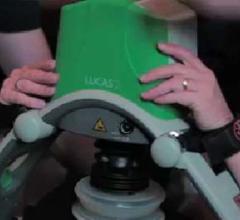November 7, 2007 - A seven-city study on the impact of new CPR techniques supports the widespread use of the American Heart Association’s new 2005 CPR guidelines, according to the study authors in a presentation at the AHA’s scientific sessions on Nov. 4 in Orlando.
Lead author Tom P. Aufderheide, M.D., professor of emergency medicine and director of the Resuscitation Research Center in the Department of Emergency Medicine at the Medical College of Wisconsin in Milwaukee, presented the data showing a doubling of hospital discharge rates when the AHA’s new CPR guidelines were consistently applied to 893 patients.
The EMS departments submitting data in the study, which tracked individuals who experienced cardiac arrest outside of the hospital all the way through hospital discharge. When subjects were treated with new CPR techniques including the use of the ResQPOD, an impedance threshold device (ITD), the hospital discharge rates jumped from 7.9 percent to 15.7 percent, or double the survival rate of the control group.
“This menu of interventions for patients with cardiac arrest has resulted in one of the highest overall survival rates ever documented for this devastating medical condition,” Dr. Aufderheide said. “It represents a major breakthrough in the treatment of cardiac arrest, which we hope will be disseminated in other systems throughout the United States.”
The seven EMS departments participating in the study used AHA-recommended new CPR including increased compressions, full chest wall recoil and use of the impedance threshold device. The ResQPOD ITD is a $99 device that is the size of a small fist and manufactured by Advanced Circulatory Systems (ACSI).
The ITD received a Class IIa rating by the AHA in its 2005 Emergency Cardiac Care Guidelines. This is the highest recommendation possible given to an intervention that improves hemodynamics and improves the rate of return of spontaneous circulation after cardiac arrest.
“There are technologies and practices that we know can move the needle to save more lives,” said Dr. Keith Lurie, chief medical officer at Advanced Circulatory Systems. “This is especially true when we use these therapies together as recommended in the American Heart Association 2005 Guidelines. People should not have to rely on being in the right place at the right time when they experience cardiac arrest. While there remains a lot of work to further increase survival rates, the findings from this study, that survival to hospital discharge rates are doubled with this new approach, has great value for all patients who suffer from a cardiac arrest.”
For more information: www.advancedcirculatory.com

 April 02, 2019
April 02, 2019 



